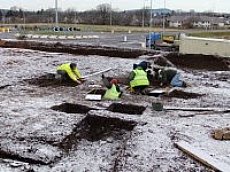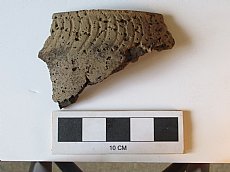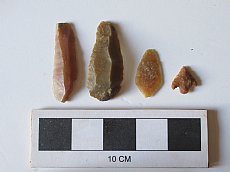Lower Slackbuie, Inverness (ASDA) Neolithic site
02 March 2021
- News Type:
- Site of the Month

© NG Archaeology Services
Excavations in 2011 in advance of construction of an ASDA superstore to the south of Inverness have revealed remains of an important Neolithic settlement, with later occupation in the Bronze Age and probably Early Medieval period, including two ring ditches, a possible cairn/house, a palaeochannel with pottery and lithics, and a large number of pits. In total 999 prehistoric pottery sherds, almost all Neolithic and 2163 pieces of flaked lithics were found, the largest lithic assemblage found at a Late Neolithic site on the Scottish mainland. A variety of stone tools, two albertite beads, and some ironworking evidence were also found. A large number of burnt and unburnt bones were also found; many of the other finds were also burnt.
Stones and slabs thought to be either a cairn or house outlined an area 15m by 7m. Within, around and below the structure were a barbed and tanged arrowhead, a possible cup-marked quern stone and Early-Middle Neolithic pottery. To the north stakeholes around a pit were found, and other hints of structures survive. The palaeochannel or buried stream had been infilled during the historic period. It preserved a large number of redeposited lithics and pottery sherds.

The pottery is an important assemblage of Neolithic pottery, with Early-Mid Neolithic Modified Carinated Bowl and Impressed Ware, and Late Neolithic Grooved Ware represented, the latter especially in the palaeochannel, though it is unclear how it ended up there, whether as deliberate deposition or simply a clearing out. The presence of Early-Middle Neolithic pottery in pits is common in the area and elsewhere in the Highlands. Here, the radiocarbon dates suggest 3600-2900 BC. The Impressed Ware dates are generally earlier than elsewhere, but contribute to the ongoing discussion of dating and the possibility of a northern development. The Grooved Ware finds contribute to a growing picture of use in the Inverness area. In particular, finds from nearby Culduthel show similar pottery types . Much of the pottery has charred residues and includes burnt sherds, suggesting domestic cooking uses. Only one Beaker sherd was found, suggesting activity on much of the site is primarily Neolithic.

Over 90% of the lithics were found in the palaeochannel, with the remainder mainly from pits. The large assemblage may in fact be the result of excavation of a dump area, whereas many other Late Neolithic sites have concentrated on areas of structures. A few Mesolithic lithics were found, suggesting activity in the area, but little indication of its nature. The other lithics are generally Late Neolithic. Much of the material was knapping debris, but also included two leaf points, one barbed and tanged arrowhead (of a type which might date to the Late Neolithic), and a range of blades and scrapers. Flint was most common, with some of it seemingly from Yorkshire, and used for special tool types. A small amount of quartz and chert as well as a pitchstone core were also found, showing contacts with Arran, although its date cannot be determined. A fifth of the flint assemblage was burnt, though whether accidental or deliberate is unclear. Few lithics were found near the cairn/house, in contrast to the coarse stone tools.
Stone tools were an interesting mixture including cobble tools, querns and rubbers, anvils, a stone axe, and a fragment of possibly another. The axehead, unfortunately unstratified, was heavily worked and re-used. One of the saddle querns indicates Late Neolithic activity while the other two suggest later Bronze Age. At least one hammerstone was probably used for flint knapping.
Two jet-like beads were found, and when analysed turned out to be of albertite which outcrops at Strathpeffer in Easter Ross. These appear to be abandoned roughouts, perhaps for a flat-sided circular bead, an unusual shape for Neolithic or Bronze Age Scotland. Their dating is unclear, but thought likely to be Bronze Age.
Iron working evidence included slag, a smithing pan and smelting slag, most undiagnostic. One pit containing iron debris was dated to AD 885-994.
Bone preservation was good, with 3447 fragments, burnt and unburnt. All were animal, including sheep/goats, deer and cattle, and thought to derive from waste from domestic hearths. Much was abraded, but there is perhaps scope for further work on the finds.
Environmental analysis revealed high concentrations of carbonised cereal grain and chaff, weed seeds and hazelnut shells. Naked barley was most common, with emmer wheat and to a lesser degree oat grains which may represent a weed rather than cultivated plant in early deposits. Radiocarbon dating indicated Neolithic to Bronze Age dates, but further work on some samples might show different trends within the site. Five possible flax seeds were also found, but not dated. The large presence of chaff in a few contexts is unusual for Scottish sites, and suggests grains stored on the ear; however, overall the quantity of chaff was low suggesting grain had already been threshed and winnowed. Some clusters of burnt grain suggest possible stores destroyed by fire or during food preservation. The large assemblages of charred hazelnut shell suggest possibly drying/ roasting pits. Charred remains of an apple/pear pip and plum suggest wild fruit collection, a relatively rare find for prehistoric Scotland.
Charcoal allowed seven species to be identified, although preservation was poor. Hazel predominated, followed by oak and birch, but only a single pine fragment.
A number of radiocarbon dates were undertaken, some to help date key pottery finds. The report does not allow detailed analysis of these, but summaries identify areas with Neolithic, Bronze Age or multiperiod occupation. Certainly more work could be applied here, particular to target the enigmatic cairn/house.
The results from these excavations add to information from other multi-period sites in the area. While there is no further possibility of work at this site, areas on its edges hold some potential, and there is scope for more post-excavation analysis to clarify datings, environmental information and the nature of the cairn/building. This important site deserves to be better known, with a mainstream publication.
Further information:
Garry, Nick nd ‘Excavations of Lower Slackbuie, Inverness, prehistoric site, project codes SL09 andSL09WB for ASDA Stores’. Report attached to Highland HER EHG3271
Anderson, Sue 2012 (ed) ‘Slackbuie, Inverness (SL09). Finds reports and assessment report no. 2116’ Report attached to Highland HER EHG3271
Site of the Month Archive
- 10/04/2021 Easter Raitts township
- 02/03/2021 Lower Slackbuie, Inverness (ASDA) Neolithic site
- 01/02/2021 Balnuaran of Clava cairns
- 04/01/2021 Wilkhouse Inn
- 02/12/2020 Spinningdale Cotton Mill
- 02/11/2020 Skibo A Canadian Forestry Camp
- 01/10/2020 WWI Detonator Store, Dalmore near Invergordon
- 03/09/2020 Mesolithic Shell Midden at Sand, Wester Ross
- 08/08/2020 Kinbeachie Neolithic settlement
- 01/07/2020 Armadale Cist Burial and Stone & Timber Complex
